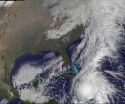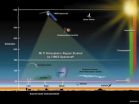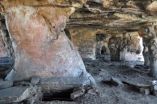(Press-News.org) HOUSTON -- (Nov. 5, 2010) -- A new study by Rice University bioengineers finds that the workhorse proteins that move cargo inside living cells behave like prima donnas. The protein, called kinesin, is a two-legged molecular machine. Rice's scientists invented tools that could measure the pulling power of kinesin both singly and in pairs, and they report this week in Biophysical Journal that kinesins don't work well together -- in part because they are so effective on their own.
"Researchers have been investigating the mechanical properties of individual motor proteins for some time now, but this is the first time anyone's been able to tie a defined number of molecular motors to a cargo and watch them work together," said lead researcher Michael Diehl, assistant professor in bioengineering at Rice. "We know that more than one of these motors is attached to most cargoes, so understanding how they work together -- or fail to -- is a key to better understanding the intracellular transport system."
Cargoes inside cells are hitched to teams of motor proteins and hauled from place to place like horse-drawn wagons. Like stagecoaches or wagons, many cargoes are pulled by several horses. But unlike a wagon, cellular cargoes often also have multiple teams pulling in opposite directions.
"Motor proteins move directionally," Diehl said. "They either move toward the cell's nucleus or they move away from the nucleus toward the periphery. Grouping different types of motors together allows cells to regulate cargo movement. But when there are multiple motors pulling antagonistically in opposite directions, what determines which group wins? What influences the balance? How do they cooperate or compete to get the right packages to the right place? Those are the kinds questions we're trying to answer."
Diehl said intracellular transport has become an increasingly hot topic over the past decade, in part because researchers have found that breakdowns in the transport system are linked to neurodegenerative diseases like amyotrophic lateral sclerosis (ALS) and Huntington's disease.
One question Diehl and lead co-authors Kenneth Jamison and Jonathan Driver helped answer in the new study is how much pulling power a pair of kinesins could apply to a cargo compared with the amount applied by a single kinesin.
The apparatus they created to study the problem was years in the making. Driver and Jamison, both graduate students, used strands of DNA to make a scaffold, a sort of molecular yoke that they could use to hitch a pair of kinesins to an experimental cargo. The cargo in their tests was a microscopic plastic bead. Using laser beams in an instrument called an optical trap, they attached teams of bead-pulling proteins to microtubule roadways.
As the motors walked down the road, they pulled the bead away from the center of the optical trap. At the same time, the lasers in the trap exerted counterpressure in an effort to move the bead back to the center of the trap. Eventually, the light won out, forcing the motors to let go and the cargo to snap back to the middle of the beam. By measuring the precise movements of the bead during this reaction, Diehl's team was able to determine exactly how much force a team of motors exerted on a bead.
"Compared with other motors, kinesin is actually a pretty strong performer," he said. "Single kinesin motor molecules can produce relatively large forces, and they rarely step in the wrong direction when walking along microtubules. This is remarkable behavior, considering kinesin is a molecular-scale machine that experiences significant thermal and chemical fluctuations."
Given how well they perform alone, it would be easy to assume that a group of kinesins would pull harder than a single kinesin. But Diehl points out that a team of kinesins can only harness the combined potential of both motors under certain circumstances.
"Our analyses show that the two kinesins must stay in close proximity to one another to cooperate effectively," he said. "Otherwise, one of the motors will tend to assume all of the applied force imposed on the cargo. Kinesin is relatively fast and efficient on its own, but they have trouble keeping up with one another when they are connected together."
Diehl said the group suspects that other classes of motor molecules, which are somewhat weaker than kinesin, may function better in groups. The team is carrying out follow-up experiments to see if that's the case, and they are examining how such distinctions may play a role in regulating cargo movement in cells.
Diehl's research group, which is located in Rice's new BioScience Research Collaborative, has spent years refining the tools used in the new study, and the work is paying off in numerous ways. Within the past four months, the group won an R01 grant from the National Institutes of Health worth more than $1.4 million, and Diehl also published a theoretical study of motor proteins with Rice chemist Anatoly Kolomeisky.
INFORMATION:
Diehl's research is funded by the National Institutes of Health, the National Science Foundation and the Welch Foundation.
'Prima donna' protein doesn't work well in pairs
Rice University bioengineers measure pulling power of hitched pairs of protein motors
2010-11-06
ELSE PRESS RELEASES FROM THIS DATE:
Story tips from the Department of Energy's Oak Ridge National Laboratory, November 2010
2010-11-06
VEHICLES -- Charge on the fly . . .
A prototype charging system for electric and hybrid vehicles is helping demonstrate a technology that could one day play a key role in the electrification of America's highways. The bench-scale prototype developed at Oak Ridge National Laboratory is allowing researchers to quantify the power transfer parameters necessary to wirelessly charge stationary and moving vehicles. "Our laboratory tests have been successful in transmitting greater than 4 kilowatts," said Laura Marlino of the Energy and Transportation Science Division. "This ...
GOES-13 Satellite sees Hurricane Tomas lashing Haiti and eastern Cuba today
2010-11-06
Tomas strengthened to hurricane status and is currently lashing Hispaniola and eastern Cuba today and the GOES-13 satellite provided a visible image of its extensive cloud cover.
The Geostationary Operational Environmental Satellite known as GOES-13 captured a visible image of Hurricane Tomas on Nov. 5 at 1331 UTC (9:31 a.m. EDT) centered over the southwestern tip of Haiti. In the image the clouds to the north of Tomas are associated with a cold front off the eastern U.S. coast. GOES satellites are operated by NOAA. The NASA GOES Project at NASA's Goddard Space Flight ...
NASA extends TIMED mission for fourth time
2010-11-06
Nine years after beginning its unprecedented look at the gateway between Earth's environment and space, not to mention collecting more data on the upper atmosphere than any other satellite, NASA's Thermosphere Ionosphere Mesosphere Energetics and Dynamics (TIMED) mission has been extended again.
Before the launch of TIMED, the mesosphere and lower thermosphere/ionosphere -- which help protect us from harmful solar radiation -- had been one of the least explored and understood regions of our environment.
"The middle part of the atmosphere was the part we kind of ignored," ...
Understanding diabetes at the molecular level
2010-11-06
United States and Japanese researchers have identified a key step in metabolic pathways linked to diabetes and cancer. The study on activation of the protein complex TORC 2 was published online in the journal Current Biology Oct. 28.
TORC 2 activates a protein called Akt, which plays a crucial role in how cells respond to insulin, said Kazuo Shiozaki, professor of microbiology in the College of Biological Sciences at UC Davis and senior author on the paper.
Normally, insulin triggers fat and muscle cells to take up sugar from the blood. Patients with type II diabetes ...
Johns Hopkins researchers reshape basic understanding of cell division
2010-11-06
By tracking the flow of information in a cell preparing to split, Johns Hopkins scientists have identified a protein mechanism that coordinates and regulates the dynamics of shape change necessary for division of a single cell into two daughter cells.
The protein, called 14-3-3, sits at an intersection where it integrates converging signals from within the cell and cues cell shape change and, ultimately, the splitting that allows for normal and abnormal cell growth, such as in tumors.
In a report published Nov. 9 in Current Biology, the Hopkins team links 14-3-3 directly ...
Specialization builds trust among Web users
2010-11-06
If you name it, they will use it, according to a team of international researchers who investigated how people perceive the trustworthiness of online technology. In an experiment, participants said they trusted websites, recommendation-providing software and even computers labeled to perform specific functions more than the same Internet tools with general designations, according to S. Shyam Sundar, Distinguished Professor of Communications, Penn State.
"In general, the attribution of specialization can increase the credibility of a product or any kind of object," Sundar ...
2008 Wenchuan earthquake: a landmark in China's history
2010-11-06
November 5, 2010 -- The devastating 2008 Wenchuan earthquake marks a defining moment for China's earthquake science program. The focus of a special November issue of the prestigious Bulletin of the Seismological Society of America (BSSA), the M 7.9 earthquake has garnered intense interest among seismologists, allowing the Chinese science community to demonstrate its capability to a global audience.
The earthquake produced an enormous disaster, killing more than 80,000 people and leaving more than four million people homeless. Destruction was widespread, though recent ...
Chefs can create reduced-calorie restaurant foods
2010-11-06
Restaurants could play an important role in helping to reduce the growing obesity epidemic by creating reduced-calorie meals, according to Penn State researchers.
The researchers surveyed chefs, restaurant owners, and culinary executives from across the country to assess their perceptions of serving healthy foods in restaurants.
In the survey, 72 percent of the 432 respondents said they could trim off 10 percent of the calories in meals without customers noticing differences in taste, and 21 percent said they could trim off at least 25 percent of the calories. This ...
World's oldest ground-edge implement discovered in northern Australia
2010-11-06
The oldest ground-edge stone tool in the world has been discovered in northern Australia by a Monash University researcher and a team of international experts.
Evidence for stone tool-use among our earliest hominid ancestors dates to 3.4 million years ago, however, the first use of grinding to sharpen stone tool edges such as axes is clearly associated with modern humans, otherwise known as Homo sapiens sapiens.
Monash University archaeologist and member of the team who made the discovery, Dr Bruno David said while there have been reports of much older axes being ...
Design Your Own Holiday Photo Cards
2010-11-06
Photo Card Maker http://www.photo-card-maker.com/index.html is a professional and totally free photo cards designer, which can help people make beautiful and unique holiday photo cards. Besides making holiday photo cards, people can also use it to design photo greeting cards, Christmas cards, photo invitation cards, birthday cards, thank you cards, announcements and more.
Photo Card Maker is quite easy to operate, for it mainly contains three components, namely Template, Photo and Text. There are various kinds of templates within the program for designers to choose, ...
LAST 30 PRESS RELEASES:
GIMM uncovers flaws in lab-grown heart cells and paves the way for improved treatments
Cracking the evolutionary code of sleep
Medications could help the aging brain cope with surgery, memory impairment
Back pain linked to worse sleep years later in men over 65, according to study
CDC urges ‘shared decision-making’ on some childhood vaccines; many unclear about what that means
New research finds that an ‘equal treatment’ approach to economic opportunity advertising can backfire
Researchers create shape-shifting, self-navigating microparticles
Science army mobilizes to map US soil microbiome
Researchers develop new tools to turn grain crops into biosensors
Do supervised consumption sites bring increased crime? Study suggests that’s a myth
New mass spec innovation could transform research
Maternal nativity, race, and ethnicity and infant mortality in the US
Migration-related trauma among asylum seekers exposed to the migrant protection protocols
Jupiter’s moon Europa has a seafloor that may be quiet and lifeless
SwRI upgrades nuclear magnetic resonance laboratory for pharmaceutical R&D
House sparrows in northern Norway can help us save other endangered animals
Crohn's & Colitis Foundation survey reveals more than 1/3 of young adults with IBD face step therapy insurance barriers
Tethered UAV autonomous knotting on environmental structures for transport
Decentralized social media platforms unlock authentic consumer feedback
American Pediatric Society announces Vanderbilt University School of Medicine as host institution for APS Howland Visiting Professor Program
Scientists discover first method to safely back up quantum information
A role for orange pigments in birds and human redheads
Pathways to net-zero greenhouse gas emissions for Southeast Asia
A JBNU–KIMS collaborative study on a cost-effective alloy matches superalloys for power plants and energy infrastructure
New study overturns long-held model of how plants coordinate immune responses.
New AI model predicts disease risk while you sleep
Scientists discover molecular ‘reshuffle’ and crack an 80-year-old conundrum
How stressors during pregnancy impact the developing fetal brain
Electrons lag behind the nucleus
From fungi to brain cells: one scientist's winding path reveals how epigenomics shapes neural destiny
[Press-News.org] 'Prima donna' protein doesn't work well in pairsRice University bioengineers measure pulling power of hitched pairs of protein motors



